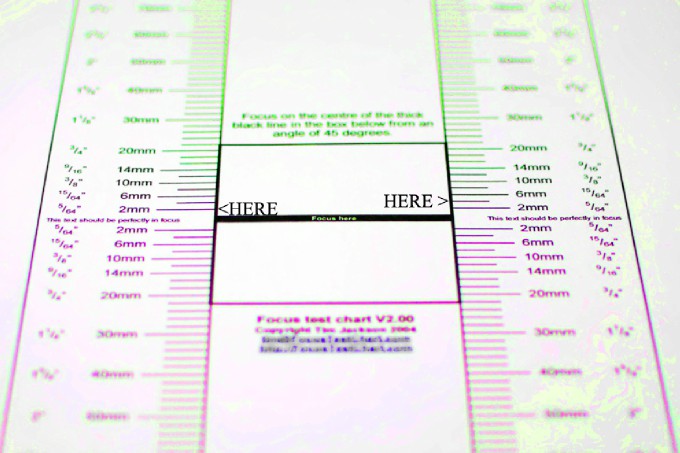Results 1 to 13 of 13
Thread: FF or not FF?
-
8th November 2012, 07:22 PM #1
-
8th November 2012, 07:55 PM #2

- Join Date
- Apr 2012
- Location
- Dunedin New Zealand
- Posts
- 2,697
- Real Name
- J stands for John
Re: FF or not FF?
It does seem to be focusing beyond the point you focused on ... if the thick line is that distance.
-
8th November 2012, 08:25 PM #3

- Join Date
- Jan 2009
- Location
- South Devon, UK
- Posts
- 14,802
Re: FF or not FF?
Have you repeated the tests?
These focus charts give an indication, but they aren't totally accurate.
-
8th November 2012, 09:01 PM #4
Yes, I did, all tests look the same as the image I uploaded
-
8th November 2012, 09:18 PM #5
Re: FF or not FF?
Hi Iosif
I'm no expert on this sort of thing but I did try the test once with one of my lenses. I came to the conclusion that the test couldn't really be relied upon to give a precise result. Having said that however your result does seem to indicate that the sharpest focus is around the 6mm point behind the "focus here" point - at least to my eyes. Wouldn't this be back focus ?
Another test you might like to try is to attach some sort of test chart vertically to a wall, set your camera up on a tripod so that it is level with the centre of the chart and is facing at right angles to the chart. Then do comparison shots using autofocus (centre point) and either manual focus in magnified Live View and/or Live View mode focus (contrast detection). The latter two modes use the main sensor as the focus detector and should be spot on whereas the autofocus uses a different light path to the phase detect sensors which is where a calibration problem might occur.
Dave
-
8th November 2012, 09:22 PM #6
Re: FF or not FF?
Try this test here and see what happens.
http://photographylife.com/how-to-qu...tofocus-issues
-
8th November 2012, 09:37 PM #7
-
8th November 2012, 09:51 PM #8
Re: FF or not FF?
Another indication of the focus point is where the spherochromatism color shift goes from purple to green which looks like it is at the -6mm point.
John
-
8th November 2012, 10:26 PM #9
Re: FF or not FF?
The problem here is if you only have one lens and use one of these test and it dose show a problem then you won't know if it's the lens or camera body.
-
8th November 2012, 10:46 PM #10
Re: FF or not FF?
It looks back focused.
The problem with these tests is that the focus point is much larger than you think. So the camera may have focussed behind the line anyway. You need a planar target.
Find a flat target with some fine details, e.g. A poster on a wall. Setup a camera on a tripod and lens perpendicular to the wall (so the sensor is parallel). Focus in live view and take a photo. Then switch to phase detect mode and focus. Repeat the test a few times defocusing to infinity each time to get some data.
Then compare the phase detect images to the contrast detect images. If the phase detect images are worse then you have a front/back focus and can try and figure out which using an angled ruler next to a planar target. If both sets are equally blurred then you may have an issue with the lens. If both are equally sharp then the calibration is fine.
Alex
-
8th November 2012, 11:10 PM #11
Re: FF or not FF?
I am CERTAINLY no expert. But the focus on the right hand side looks to my eyes a lot sharper than on the left. What does this show?
I have been trying the same focus chart with my Sigma 17-70, which has a reputation for front focusing, but I've struggled to decide just what it is telling me
-
9th November 2012, 01:43 AM #12
Re: FF or not FF?
No.
You could conclude that for this test (and considering that ALL your other tests appeared similar) the lens and camera combination might be making a slight back-focus.
***
My conclusions are:
The Lens is at the point of sharpest focus on then Left and Right Scales at the positions indicated by the “<” and “>”.

***
I concur.
The left scale, overall, is less sharp than the right scale.
I would first suspect that the lens is not at 90° in the Horizontal Plane to the test cart and / or the chart is slightly bowed.
However if the lens was set absolutely perpendicular to the target, in the Horizontal Plane (unlikely) and the test chart was indeed flat: this result would mostly indicate a misaligned Element or Group in the Lens: but the deviation is very slight in this sample.
***
Consideration of the SD (Subject Distance) should factor in how much relevance this bench test actually has on real world results.
In that regard I ask – what was the Subject Distance?
If the SD is short – then although a fun test to do, it is very most likely of very little practical purpose.
WW
-
9th November 2012, 07:47 AM #13

 Helpful Posts:
Helpful Posts: 

 Reply With Quote
Reply With Quote




 ) and also for the advices.
) and also for the advices.
